pemodelan kasus penggunaan adalah alat yang berguna untuk menangkap kebutuhan. Ini memberikan representasi grafis dari kebutuhan sistem perangkat lunak.
Dengan penerbitan Ivar Jacobson (1991) buku Rekayasa Perangkat Lunak Berorientasi Objek, Pendekatan Berbasis Kasus Penggunaan, pemodelan kasus penggunaan secara efektif menjadi teknik analisis praktis”. Saat ini, Jacobson terus mempromosikan pendekatan ini untuk analisis sistem dan telah meningkatkannya menjadi Use Case 2.0, yang secara resmi merupakan salah satu 14 jenis diagram UML.
Karena model kasus penggunaan sederhana dalam konsep dan penampilan, relatif mudah untuk mendiskusikan kebenarannya dengan personel non-teknis (seperti pelanggan).
Kasus penggunaan bukanlah prosedur, proses, atau fungsi.
Elemen dari Diagram Kasus Penggunaan
Elemen dari diagram kasus penggunaan adalah aktor (entitas eksternal) dan kasus penggunaan itu sendiri. Secara luas, kasus penggunaan adalah unit fungsional (kebutuhan) atau layanan dalam suatu sistem.
Aktor
Seorang aktor adalah entitas apa pun yang eksternal terhadap sistem desain, baik itu orang atau entitas non-manusia lainnya. Pengguna sistem adalah contoh tipikal dari seorang aktor. Jenis aktor lainnya termasuk sistem perangkat lunak yang sedang diintegrasikan dengan sistem saat ini (misalnya, sistem basis data), perangkat keras eksternal seperti sensor dan sebagainya.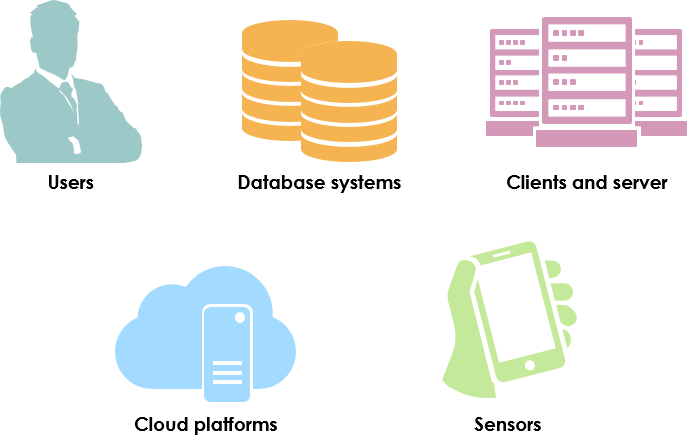
Ada dua notasi dalam spesifikasi UML:

Menggunakan stickman untuk aktor lebih ekspresif, tetapi dapat menyebabkan kebingungan jika aktor sebenarnya bukan orang, tetapi mesin atau perangkat eksternal. Simbol persegi panjang adalah notasi standar notasi UML untuk sebuah kelas.
Seorang Aktor adalah Peran daripada Orang Nyata
Seorang aktor mewakili peran entitas yang berinteraksi dengan sistem saat ini, bukan sebuah instansi.Notasi aktor menunjukkan bahwa entitas adalah sebuah kelas alih-alih instansi yang dibaca (yaitu pengguna nyata John atau Mary). Alasan mengapa seorang aktor adalah tipe kelas adalah karena itu bukan aktor itu sendiri, tetapi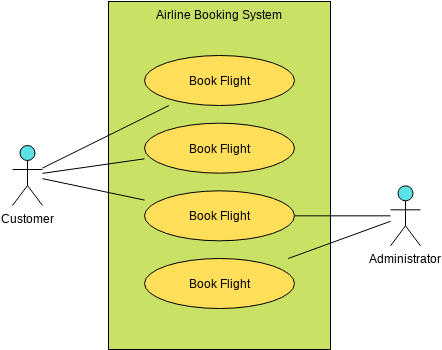 peran yang dia mainkan.
peran yang dia mainkan.
Sebagai contoh, seorang aktor dapat mewakili pelanggan bank, alih-alih menentukan aktor terpisah untuk setiap pelanggan. Demikian pula, mungkin ada aktor lain yang mewakili manajer bank. Menariknya, di dunia nyata, manajer bank juga bisa menjadi pelanggan bank yang sama. Dengan kata lain, orang yang sama memainkan peran sebagai pelanggan dan manajer.
Aktor Utama dari sebuah kasus penggunaan adalah pemangku kepentingan yang memerlukan sistem untuk menyediakan layanannya. Ia memiliki tujuan yang terkait dengan sistem – tujuan yang dapat dipenuhi oleh operasi sistem. Aktor utama biasanya, tetapi tidak selalu, adalah aktor yang memicu kasus penggunaan.
Aktor Sekunder digunakan oleh sistem, tetapi mereka tidak berinteraksi dengan sistem sendiri. Dengan kata lain, aktor sekunder tidak memulai kasus penggunaan apa pun.
Kasus penggunaan biasanya dimulai oleh aktor utama. Sistem menggunakan aktor sekunder seperti basis data melalui serangkaian kasus penggunaan. Asosiasi antara kasus penggunaan dan peserta mewakili komunikasi dua arah.
Dengan demikian, untuk setiap kasus penggunaan yang dimulai oleh aktor utama, kasus penggunaan yang terhubung harus direspon. Demikian pula, untuk setiap asosiasi antara aktor sekunder dan kasus penggunaan, komunikasi dimulai dengan kasus penggunaan dan aktor sekunder harus merespons inisiasi.
Kasus Penggunaan
Kasus penggunaan mewakili fungsi (biasanya kebutuhan) yang diharapkan diimplementasikan oleh sistem. Rincian dari kasus penggunaan, kecuali namanya yang unik, tidak diekspresikan secara intuitif dalam diagram; Rincian ini diberikan dalam deskripsi kasus penggunaan.
Kasus penggunaan biasanya dimulai oleh aktor kunci. Sistem menggunakan basis data dan peserta tambahan lainnya melalui serangkaian kasus penggunaan.
Asosiasi antara kasus penggunaan dan aktor mewakili komunikasi dua arah. Oleh karena itu, untuk setiap kasus penggunaan yang dimulai oleh aktor utama, yang terakhir harus direspon. Demikian pula, untuk setiap asosiasi antara aktor sekunder dan kasus penggunaan, komunikasi dimulai dengan kasus penggunaan, dan aktor sekunder harus merespons inisiasi.
Batas Sistem
Batas sistem mendefinisikan sistem yang menjadi perhatian sehubungan dengan dunia di sekitarnya.
Contoh Diagram Kasus Penggunaan: Sistem Pemesanan Penerbangan
Kasus penggunaan mendefinisikan interaksi antara aktor eksternal dan sistem untuk mencapai tujuan tertentu. Diagram kasus penggunaan terdiri dari empat komponen utama
Dalam diagram kasus penggunaan dari sistem pemesanan tiket, sistem diwakili oleh kotak yang berisi banyak kasus penggunaan yang berbeda. Aktor utama adalah pelanggan dan aktor sekunder adalah administrator. Pelanggan memulai kasus penggunaan, seperti memesan, menjelajahi, dan membatalkan penerbangan, sementara administrator memulai kasus penggunaan, seperti memperbarui catatan penerbangan, tetapi dianggap sebagai aktor sekunder dalam kasus penggunaan pembatalan penerbangan, karena dia hanya membantu menyelesaikan kasus penggunaan yang dimulai oleh pelanggan.

Edit contoh Diagram Kasus Penggunaan UML ini
Menyusun Kasus Penggunaan
Menurut bidang aplikasi dan pilihan desainer, sebuah kasus penggunaan dapat dipecah menjadi beberapa kasus penggunaan, yang terhubung melalui hubungan < < include > > atau < < extend > >.
Tautan Asosiasi mewakili komunikasi dua arah antara seorang aktor dan sebuah kasus penggunaan, dan oleh karena itu merupakan hubungan biner. Karena ini adalah komunikasi dua arah, untuk setiap kasus penggunaan yang dimulai oleh aktor utama, aktor tersebut harus mendapatkan respons dari kasus penggunaan.

Demikian pula, untuk setiap komunikasi antara kasus penggunaan dan aktor sekunder (yang dimulai oleh kasus penggunaan), aktor sekunder harus mengirimkan respons kembali ke kasus penggunaan.
Generalisasi
Generalisasi mewakili hubungan antara
- peran atau
- kasus penggunaan.
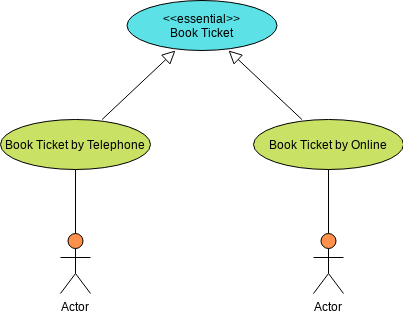
Edit template Diagram Kasus Penggunaan UML ini
Jika dua aktor terhubung oleh hubungan ini, maka aktor (atau kasus penggunaan) di ujung panah (terhubung ke bagian bawah segitiga) adalah versi khusus dari aktor (atau kasus penggunaan) di ujung lainnya.
Biasanya, aktor (atau kasus penggunaan) di ujung bawah (terhubung ke bagian bawah segitiga) disebut sebagai versi khusus dari aktor (atau kasus penggunaan) di ujung lainnya.
Generalisasi berarti bahwa versi khusus memiliki setiap fitur dari versi umum, dan mungkin lebih.
Sertakan adalah jenis hubungan khusus antara dua kasus penggunaan. Jika sebuah kasus penggunaan A menyertakan kasus penggunaan lain B, maka implementasi A memerlukan implementasi B untuk menyelesaikan tugasnya. Namun, B independen dari dirinya sendiri. Artinya, B tidak perlu mengetahui apa pun tentang A. B juga dapat disertakan dalam kasus penggunaan lainnya.
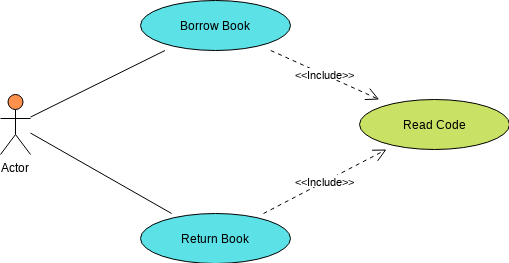
Edit contoh Diagram Kasus Penggunaan ini
Perluas adalah jenis hubungan khusus lainnya antara dua kasus penggunaan. Jika sebuah kasus penggunaan B memperluas kasus penggunaan lain A, maka implementasi A dapat secara kondisional menyertakan implementasi B untuk menyelesaikan tugasnya. Artinya, dalam beberapa kasus, A dapat menyelesaikan tugasnya tanpa B. Namun, tergantung pada kondisi yang dijelaskan.
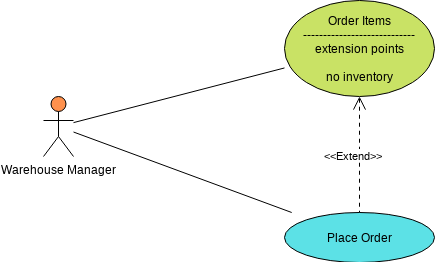
Edit contoh Diagram Kasus Penggunaan ini
Notasi Diagram Kasus Penggunaan
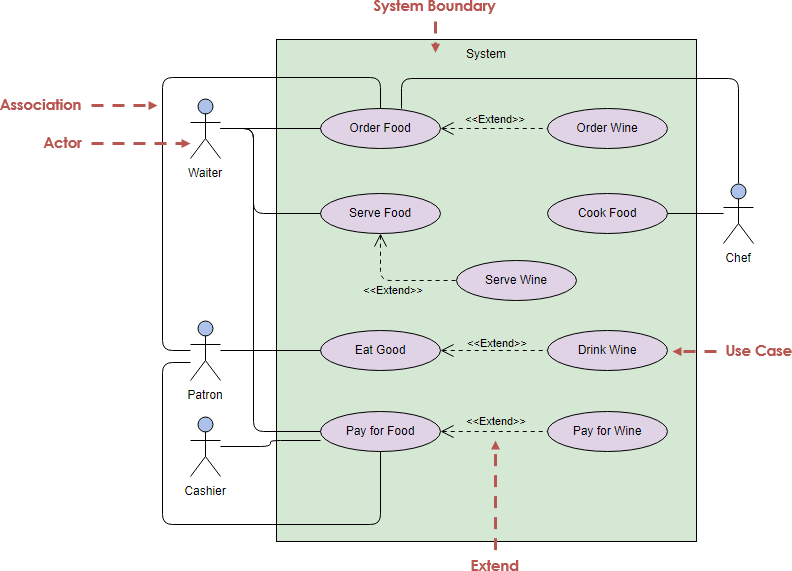
Edit contoh Diagram Kasus Penggunaan ini secara online
9 Langkah Sederhana untuk Melakukan Analisis Kasus Penggunaan
- Tentukan siapa yang akan langsung menggunakan sistem. Orang-orang ini adalah aktor.
- Pilih salah satu dari aktor ini.
- Tentukan apa yang ingin dilakukan aktor tersebut dengan sistem. Setiap hal yang ingin dilakukan aktor dengan sistem menjadi sebuah kasus penggunaan.
- Ulangi langkah 2-3 untuk semua kasus penggunaan lainnya
Identifikasi peran sekunder dan dukungan peran non-manusia untuk kasus penggunaan yang telah Anda identifikasi. - Gambarlah versi awal dari kasus penggunaan, jangan terlalu mempersulit hubungan kasus penggunaan pada titik ini
- Diskusikan dan tinjau dengan pengguna untuk memvalidasi tujuan dari setiap kasus penggunaan (manfaat dari fungsionalitas yang diusulkan) Setelah modifikasi, Anda dapat melanjutkan untuk merinci kasus penggunaan dalam langkah 8 – 10
- Untuk setiap kasus penggunaan, tentukan proses yang paling umum yang akan diikuti aktor saat menggunakan sistem. Apa yang biasanya terjadi.
- Jelaskan proses dasar ini dalam deskripsi kasus penggunaan.
- Setelah Anda puas dengan proses dasar, sekarang pertimbangkan skenario alternatif dan tambahkan ini sebagai kasus penggunaan yang diperluas.
Model dan Spesifikasi Kasus Penggunaan
Tidak cukup hanya menunjukkan diagram kasus penggunaan dalam notasi UML. Setiap kasus penggunaan disertai dengan teks yang menjelaskan tujuan dari kasus penggunaan dan fungsionalitas yang dicapai saat kasus penggunaan dieksekusi.
Sebuah kasus penggunaan menggambarkan tugas yang dilakukan oleh seorang aktor yang menghasilkan hasil nilai bisnis bagi perusahaan. Sebuah kasus penggunaan dapat divisualisasikan sebagai diagram kasus penggunaan atau/ dan dalam spesifikasi teks terstruktur format.
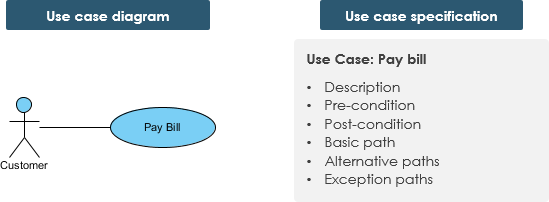
Skenario Kasus Penggunaan
Sebuah kasus penggunaan terdiri dari sejumlah skenario, masing-masing mewakili instansi spesifik dari kasus penggunaan, yang sesuai dengan input tertentu dari aktor atau kondisi tertentu di lingkungan. Setiap skenario menggambarkan cara alternatif bagi sistem untuk berperilaku, atau dapat menggambarkan kegagalan atau pengecualian.
Sebuah kasus penggunaan memiliki:
- Hanya satu tujuan
- Satu titik awal
- Satu titik akhir
- Beberapa jalur untuk mencapai dari awal hingga akhir
- yaitu Menentukan perilaku untuk berbagai kondisi yang mungkin
- Setiap kondisi mungkin memerlukan tindakan tertentu
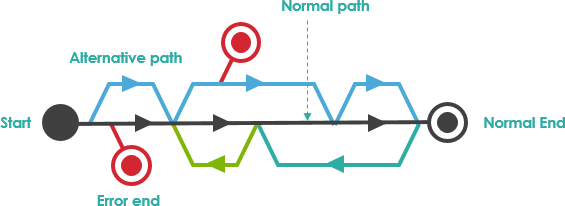
Sebagai Contoh – Pelanggan membayar tagihan:

Ada beberapa jalur untuk mencapai tujuan:
- Pembayaran telepon
- Melalui pos
- Secara langsung
- dengan cek
- dengan uang tunai, dll.
Sebuah jalur yang tidak mengarah ke tujuan:
- Kartu kredit ditolak
Pengelompokan Kasus Penggunaan dengan Paket
Anda juga dapat: Menggambar paket untuk kategorisasi logis kasus penggunaan ke dalam subsistem terkait.
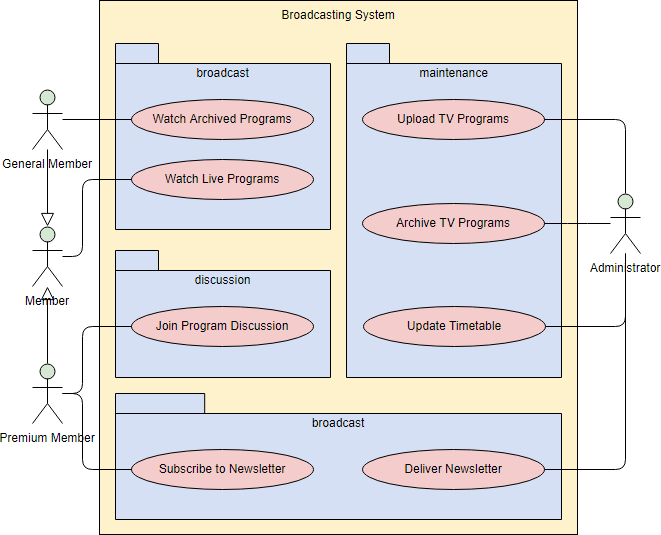
Edit contoh Diagram Kasus Penggunaan ini
Spesifikasi Kasus Penggunaan yang Detil
Sebuah kasus penggunaan yang detil adalah representasi tekstual yang menggambarkan alur peristiwa dan informasi kasus penggunaan terkait lainnya dalam format tertentu. Template kasus penggunaan standar sering digunakan untuk mendokumentasikan rincian dari sebuah kasus penggunaan.
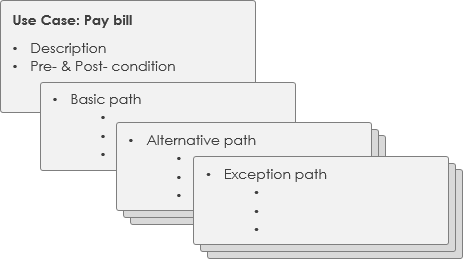
Apa itu Deskripsi Kasus Penggunaan
Sebuah deskripsi kasus penggunaan adalah deskripsi tertulis dari urutan langkah-langkah yang dilakukan seorang analis untuk menyelesaikan transaksi sistem yang lengkap. Ini dimulai oleh seorang aktor, memberikan nilai kepada aktor tersebut, dan merupakan tujuan dari aktor yang bekerja dalam sistem.
Aktor – Setiap orang atau sistem eksternal terhadap sistem yang menggunakan atau berinteraksi dengan sistem untuk mencapai tujuan. Setiap aktor diberikan peran untuk mewakili interaksi mereka dengan solusi. Aktor manusia harus diberi nama dalam bentuk peran dan tidak boleh diberikan nama sebenarnya. Aktor umumnya dikategorikan sebagai primer, sekunder, atau pemangku kepentingan.
Aktor utama – Aktor yang memulai kasus penggunaan.
Aktor sekunder – Aktor yang bereaksi atau merespons tindakan yang dilakukan oleh aktor utama.
Pemangku kepentingan – aktor di luar panggung yang tidak berinteraksi langsung dengan kasus penggunaan, tetapi memiliki kepentingan dalam hasil dari kasus penggunaan.
Alur aliran peristiwa (jalur) – urutan langkah-langkah yang harus diambil oleh aktor dan solusi untuk mengeksekusi sebuah kasus penggunaan. Secara umum, sebuah kasus penggunaan terdiri dari jalur keberhasilan utama (juga disebut dasar atau primer), jalur alternatif, dan jalur pengecualian.
Jalur Normal – input dari aktor dan respons dari sistem – mewakili jalur keberhasilan yang paling umum untuk mencapai tujuan aktor.
Jalur Alternatif – input dari aktor dan respons sistem, mewakili jalur lain yang kurang umum untuk mencapai tujuan aktor
Jalur Pengecualian – input dari aktor dan respons sistem, mewakili jalur yang tidak berhasil ketika tujuan aktor tidak dapat dicapai.
| Deskripsi Kasus Penggunaan | |
|---|---|
| Nama Kasus Penggunaan: | Tarik Tunai |
| Aktor: | Pelanggan (utama), Sistem Perbankan (sekunder) |
| Deskripsi Ringkas: | Memungkinkan setiap nasabah bank untuk menarik uang tunai dari rekening bank mereka. |
| Prioritas: | Harus Ada |
| Status: | Tingkat Rincian Sedang |
| Kondisi Awal: | Nasabah bank memiliki kartu untuk dimasukkan ke dalam ATM ATM berfungsi dengan baik |
| Kondisi Pasca: |
|
| Jalur Dasar: |
|
| Jalur Alternatif: |
|
| Aturan Bisnis: |
|
| Persyaratan Non-Fungsional: |
|
Tautan Terkait
- Apa itu Bahasa Pemodelan Terpadu?
- Slide Kasus Penggunaan / Catatan Kuliah
- Peran Kasus Penggunaan dalam Pemodelan Kebutuhan dan Analisis
- Daftar alat UML
- Coba Visual Paradigm GRATIS
- Use Case – Catatan untuk Kursus Pelatihan
- Bagaimana Menulis Use Case yang Efektif?
- Bab Buku – PDF – Model Use Case: Menulis Persyaratan dalam Konteks
This post is also available in Deutsch, English, Español, فارسی, Français, 日本語, Polski, Portuguese, Ру́сский, Việt Nam, 简体中文 and 繁體中文.













